29.03.2006
Alexander Motylev annotates the game Vallejo - Dominguez
VALLEJO - DOMINGUEZ
Cuernavaca 2006
Four Knights Opening С48
Nakamura led the tournament after three rounds with 2.5 out of 3. Both players in this game had been in the chase group – Vallejo had 2 of 3, and Dominguez scored 1.5. Each of them only one win and that`s why there is no doubt that both opponents were in a combative mood.
1.e4 e5 2.¤c3 ¤f6 3.¤f3 ¤c6 4.Ґb5. This variation has been a bit obliterated recently, but it seems to me that due to the strengthening of Black`s positions in the Petroff defense and in the Ruy Lopez it can regain its popularity in the nearest future.
4...¤d4. 4...Ґb4 leads to a more composed maneuvering play.
5.Ґc4. Another interesting continuation is 5.Ґa4.
5...Ґc5. Black`s attempt to simplify the struggle ran across an interesting novelty - 5...¤xf3+ 6.gxf3!? d6 (6...Ґc5 7.¦g1 with initiative) 7.d4! Ґe6 8.d5 Ґd7 9.f4 exf4 10.Ґxf4, and White got quite a promising position in the game Najer-Mamedyarov, played in the World Cup in Khanty Mansiysk (rapid chess).
6.¤xe5 Јe7. 6...d5!? 7.Ґxd5 ¤xd5 8.¤xd5 0–0 9.c3 ¦e8 10.cxd4 Ґxd4 11.0–0 ¦xe5 12.d3 was played in the game Shirov – Kramnik (Cazorla, 1998) The game was drawn. However, I don`t think that two bishops of Black provide sufficient compensation for a sacrificed pawn.
7.¤f3 d5 8.Ґxd5 Ґg4 9.d3.
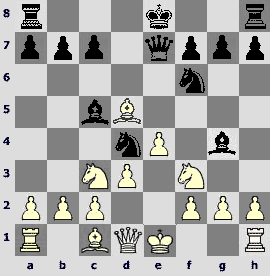
9...0–0–0!? A novelty. In this case Black had followed Rubinstein advice playing 9...c6 10.Ґb3 ¤d7, as great Akiba used to play against Bernstein in 1912. 92 years later the author of this article managed to find new ideas in this variation - 11.Ґe3!? ¤e5 12.¤xd4! Ґxd1 13.¤f5 Јf8 14.Ґxc5 Јxc5 15.d4 Јb4 16.¦xd1, and despite the absence of the queen White got good attacking prospects in the game Motylev – Shirov (Corsica 2004, rapid).
10.Ґe3. Perhapsthemostnaturalandlogicalmove. It would be interesting to check bishop retreats on c4 and b3. In both cases complex and unclear positions arise, and Black has a wide range of continuations. I will just outline the sample variations without claiming to draw the final conclusions.
а) 10.Ґb3 Ґxf3!? 11.gxf3 ¤d7 12.¤d5 Јh4 13.Ґf4 Јh5 or 13...Јh3!? The consequences are unclear as well 10...¤d7 11.¤d5 (11.Ґe3 ¤e5) 11...Јe8 12.Ґe3 (12.c3 ¤xb3 13.axb3 ¤e5 14.d4 ¦xd5 15.Ґe3!) 12...c6 (12...f5 13.Ґxd4 fxe4 14.0–0 exf3 15.Ґxc5 ¤xc5) 13.Ґxd4 cxd5 14.Ґxc5.
b) 10.Ґc4!? – looks quite risky, however I didn`t manage to find a refutation
b1) 10...c6 11.Ґe3 b5 12.Ґb3 b4 13.Ґxd4;
b2) White hangs by a thread in the variation 10...b5

11.¤xb5 ¤xf3+ (in response to 11...¤xe4 White saves by 12.¤bxd4 ¤c3+ 13.Ґe6+!; and if 11...¤xb5 12.Ґxb5 ¤xe4, then 13.Јe2) 12.gxf3 ¤xe4 13.0–0 Јh4 (13...Јf6 14.fxg4 ¤xf2 15.d4!? ¤xd1 16.¦xf6 ¦xd4 17.¤xd4 Ґxd4+ 18.ўf1 Ґxf6 19.c3 with advantage; 13...Ґh5 14.Јe2) 14.Јe2 ¤xf2 15.Ґe3 ¦he8 16.d4 – however the courage is awarded with victory;
b3) 10...¤d7 11.¤d5 Јe8 12.c3;
b4) 10...¦he8 11.Ґe3;
b5) 10...Ґxf3 11.gxf3 ¤d7 12.¤d5 Јh4 13.c3 ¤b3 14.¤e7+! ўb8 15.¤c6+! ўa8 16.d4 ¤xa1 17.¤xd8 ¦xd8 18.Ґe3, and the a1-knight will hardly help Black.
10...¤xd5. 10...¤xf3+ 11.gxf3 Ґxe3 12.fxe3 ¤xd5 13.¤xd5 Јh4+ (13...¦xd5 14.exd5 Јxe3+ 15.Јe2) 14.ўd2.
11.¤xd5 ¦xd5 (the only move) 12.exd5.
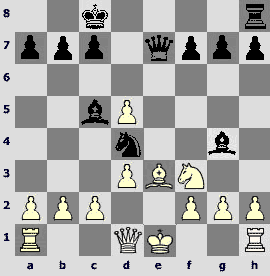
12...¦e8! This move really deserves an exclamation mark. 12...Ґxf3 13.gxf3 ¤f5 that suggested itself led to a worse position - 14.0–0! Ґxe3 15.fxe3 ¤xe3 16.Јe1! Јg5+ 17.Јg3 Јxg3+ (17...Јxd5 18.¦f2) 18.hxg3 ¤xf1 19.ўxf1 ¦d8 20.c4 c6 21.dxc6 bxc6 22.ўe2, and White keeps an extra pawn, or 16...¦e8 17.¦f2 Јg5+ 18.ўh1 Јxd5 19.Јb4 with advantage to White. Weaker is 14.Јe2 Ґxe3 15.fxe3 ¤xe3 16.ўd2 ¦e8 17.¦ae1 (17.ўc1!? Јg5 18.ўb1 Јxd5 with unclear play) 17...¤c4+ 18.dxc4 Јg5+ 19.ўd3 ¦xe2 20.¦xe2 Јf5+ 21.ўe3 Јe5+ 22.ўd3 Јf5+=.
13.c3. This leads the game to a forced draw. White had at his disposal a brave move 13.0–0. Let`s see to which position it could have led.
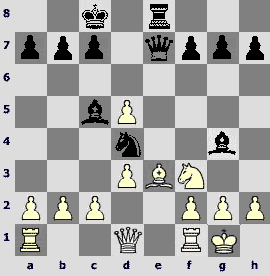
а) 13...¤xf3+ 14.gxf3 Ґh3 looks tempting. And in this situation White has to show resourcefulness.
а1) Dubious is 15.d4? Јf6 16.ўh1 Ґxf1 17.dxc5 Ґc4! with initiative;
а2) 15.¦e1! loses 15...Ґxe3 in view of a sudden blow 16.f4!! Ґxf2+ 17.ўxf2 Јh4+ 18.ўg1 or 16...Јf6 17.Јf3! One should play 15...Јh4! 16.ўh1 (16.f4 Ґg4 17.Ґxc5 Ґxd1 18.¦xe8+ ўd7 19.¦e7+ ўc8=) 16...Ґd6 17.f4 Ґg4 18.f3 Ґh5

White runs the risk. The best he can get is a draw after 19.ўg2 ¦xe3 20.¦xe3 Ґxf4! and 19.Ґxa7 Ґxf4! 20.¦xe8+ ўd7 21.¦e7+ ўc8 22.¦e2 Ґxf3+ 23.ўg1 Ґxh2+ 24.ўf1 Јh3+ 25.ўe1 Ґf4! Stronger is 19.ўg1! Јh3 (White keeps a slight advantage in 19...¦xe3 20.¦xe3 Јxf4 21.Јd2 Ґc5 22.¦ae1 Ґxf3 23.Јf2 Ґxe3 24.¦xe3 Јg5+ 25.ўf1 Ґxd5) 20.Јd2 Ґxf3 21.Јf2 Ґxd5 22.Јg3 Јh5 23.Ґd4 ¦g8!? 24.c4 Ґc6 25.¦e3! g5 26.Јh3+ Јxh3 27.¦xh3 gxf4+ 28.ўf2 ¦g2+ 29.ўf1. White probably stands better in this position. However, it required an extremely precise play, and it should also be admitted that Black has good practical chances as well.
а3) Based on the same ideas, but even more inventive: 15.f4!? Јf6!? (15...Ґxe3 16.¦e1!) 16.Јf3 Ґxf1 17.¦xf1 (17.Ґxc5 Ґe2 18.Јh3+ ўd8) 17...Ґxe3 18.fxe3 Јxb2, and Black has quite sufficient counterplay as the White`s king is weakened. Also possible is 15...Ґxf1 16.Јg4+ (16.Јxf1 Ґxe3 17.Јh3+ Јd7!?) 16...ўd8!? (16...Јd7 17.Јxd7+ ўxd7 18.Ґxc5 Ґh3) 17.ўxf1 Ґxe3 18.¦e1 Јc5 19.Јg5+ ўd7 (19...f6 20.Јxg7) 20.Јf5+ ўd8 21.fxe3 ¦xe3, andBlackholds;
b) 13...Ґxf3 14.gxf3 Ґd6! (14...Јh4 gives more opportunities) 15.f4 (15.ўg2? Јe5 16.¦h1 ¤f5 with a strong attack) 15...Јh4 16.ўh1 (in response to 16.c3 it`s possible to play the following fantasy variation - 16...Јh3!? 17.cxd4 g5! 18.¦e1 gxf4 19.Ґxf4 Ґxf4 20.¦xe8+ ўd7 21.Јa4+ c6 22.dxc6+ bxc6, and White cannot win).
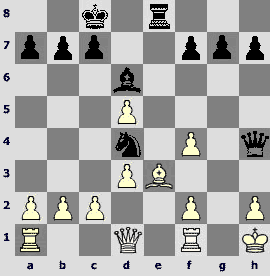
a) 16...g5 17.¦g1 (17.¦e1) 17...gxf4 18.¦g4 Јh5 19.Ґxd4 Јxd5+ 20.¦g2 Јxd4 21.Јg4+;
b) 16...¤e2 17.Јxe2 Ґxf4 18.f3;
с) 16...Ґxf4 17.Ґxf4 Јxf4 18.Јh5! ¤f3! White is a pawn and an exchange up in this position, however the f3-knight stands high! Despite the fact that computer assessment is in White`s favour, I think Black has sufficient compensation for the sacrificed material.
19.Јh3+ ўb8
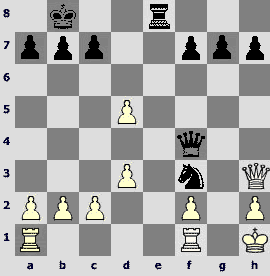
с1) 20.Јg3 Јf6 21.c4 ¦e5 22.Јh3 g6;
с2) 20.¦ad1 ¦e5 (positional 20...g5 21.Јg3 Јf6 is also good) 21.d4 ¦e2 22.Јg3 (22.¦d3 ¤d2) 22...Јe4 23.Јxg7 ¤g5+!? 24.f3 ¦xh2+ 25.ўxh2 Јh4+ with a draw;
c3) 20.c4 ¦e5 21.Јxh7 a6 22.Јh8+ ўa7 23.Јh3 g6 with a strong attack;
с4) 20.a4! (trying to bring the queen`s rook into action). In haste 20...¦e5 21.a5! a6 (21...g6 22.Јg3 Јf6 23.¦a4!) 22.Јg3 Јf6 23.¦a4 ¦h5 24.h3 Јf5 25.ўg2, and White has to fight off.
Correctis 20...a5! (preventing the rook from entering the fourth rank) 21.¦a3!? (in response to 21.b4 it`s already possible to play 21...¦e5 22.bxa5 g6 23.Јg3 Јf6, getting to the White`s king, or even 22...¤xh2 23.¦g1 g6) 21...¤d2 (not very clear is 21...¦e2 22.Јg3 Јxg3 23.hxg3 ¤d2) 22.¦g1 ¤f3 (22...¦e2 23.¦aa1) 23.Јg3 (23.¦f1) 23...Јf5 with a compensation.
Well, it seems that White came to a right decision. Black`s pieces` energy cannot be suppressed even with the help of the computer.
13...¤xf3+ 14.gxf3.
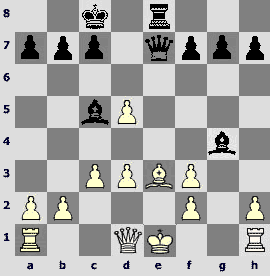
14...Јh4! But not 14...Ґxe3 15.fxg4! Starting from this moment and till the end of the game the play of the parties is forced.
15.ўd2 The only move. 15.fxg4 ¦xe3+ 16.ўd2 (16.ўf1 Јh3+ 17.ўg1 ¦g3+! 18.hxg3 Јxg3+ 19.ўf1 Јxf2#) 16...Јxf2+ 17.ўc1 ¦e2 loses.
15...¦xe3! 16.fxe3 Јf2+ 17.ўc1 Ґxf3 18.Јe1 Ґxe3+ 19.ўb1 Ґxh1 20.Јxh1 Јe2.
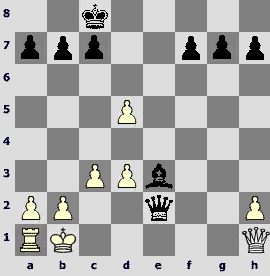
21.a4 Јxd3+ 22.ўa2 Јc4+ 23.ўb1 Јd3+. Black hardly has reasons for continuing the struggle.
24.ўa2 Јc4+ 25.ўb1. A draw. It was a short but intense fight. Well, it seems that the ball is on White`s side in this variation.
